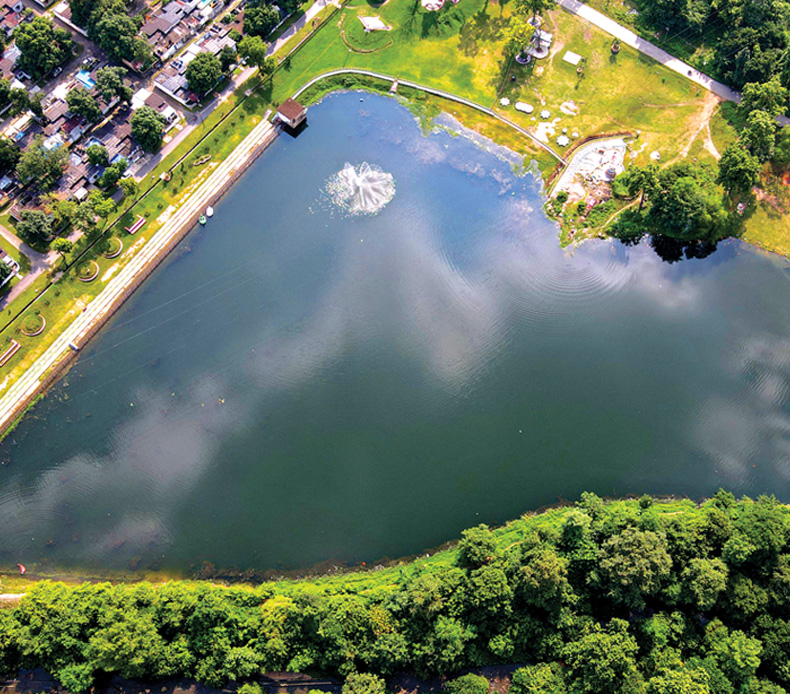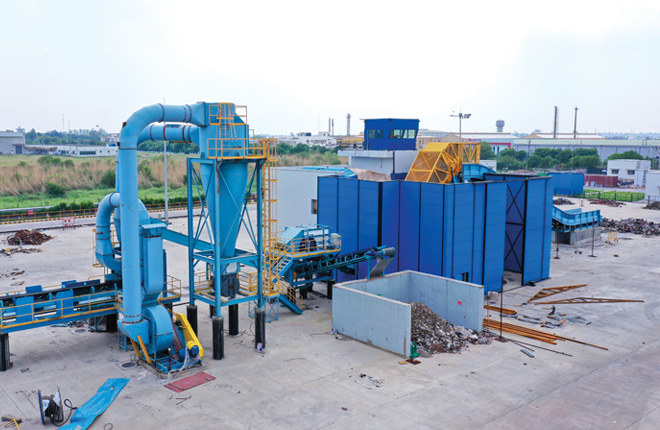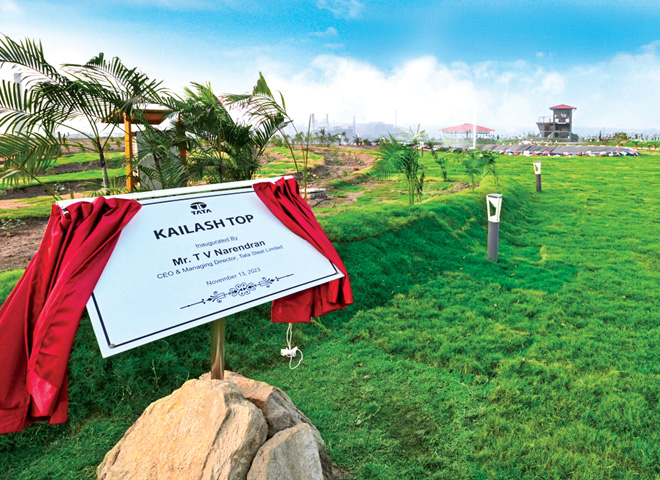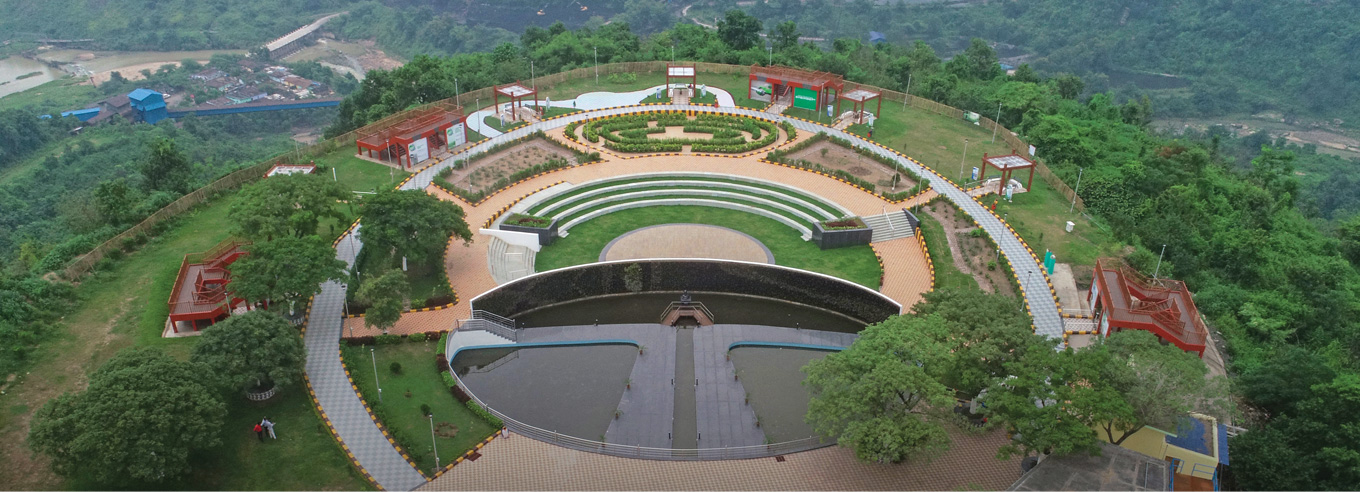Natural Capital
Tata Steel drives responsible resource use to reduce its carbon footprint, foster circular economy practices and combat climate change.
2.8 tonnes CO2e
Greenhouse gas intensity
per tonne of crude steel
(as per the GHG Protocol)
Net Zero
by 2045
Raw material
Steelmaking is a resource-intensive process with iron ore, reductant (coke) and flux as key input materials. Around 60% of the cost of crude steel is incurred till the hot metal stage, of which around 70% is attributed to coking coal.
In India, Tata Steel has six captive operating mines at Noamundi, Katamati, Joda East, Khondbond, Vijaya II and Koida. Given the planned Indian crude steel capacity expansion in the coming decade, the captive iron ore capacity also needs to be increased to remain self-reliant. Accordingly, the Gandhalpada and Kalamang iron ore leases plan to commence mining operations in the coming years. Additionally, the Company owns iron ore assets in Labrador and Northern Quebec regions of Canada.
100%
Iron ore requirement met through
captive mines in India
Apart from iron ore, around 19% of the clean coal requirement for our Indian operations is fulfilled by two operating open-cast pits in West Bokaro and three operating underground collieries in Jharia. The state-of-the-art coal washing plants with a 2 MTPA capacity in Jamadoba, 1 MTPA in Bhelatand, and 6.5 MTPA in West Bokaro, convert raw coal to clean coal used in the steelmaking process. Following the principles of circular economy, the by-products generated during clean coal production viz. middlings, tailings, and rejects, are sold for power generation. The water used for washing is recovered and recycled.
For manganese and chrome requirements, the Company has four operating manganese mines in Joda West, Khondbond, Tiringpahar, and Bamebari, and two operating chromite mines in Kamarda and Saruabil. Its ferroalloy processing plants at Joda, Bamnipal, Athagarh, Gopalpur, Jajpur, and Balasore produce different types and grades of ferroalloys, i.e. ferrochrome, silico manganese and ferromanganese.
Tata Steel is one of the world’s largest producers and exporters of ferrochrome.
Key digitalisation initiatives in mining operations
The Company has undertaken several automation and digitalisation initiatives in the mining operation and beneficiation plants as well as logistics, including setting up networks for digital communication and data transfer, sensorisation of plant equipment and mining equipment. It has enabled the automatic capturing of data using the Internet of Things (IoT), remotecontrolled operations of equipment like conveyors and pumps, centralised monitoring of plant and mine operations, Suraksha Card, video analytics, online safety management plan, and digital mine mapping using drone survey and GIS-based technologies. Digital initiatives have resulted in significant improvement in managing the assets of the Company with better efficiency.
Committed to protecting the environment
Tata Steel Limited is dedicated to preserving the environment through its ongoing efforts to curb emissions, reduce, reuse, and recycle waste, conserve biodiversity, and promote circular economy. The Company’s commitment is reflected in its investment in various environmental initiatives aligned with the Tata Group-level environmental sustainability initiative ‘Project Aalingana’. These encompass reducing air emissions, promoting nature-based solutions, increasing steel scrap usage, reducing water consumption, minimising waste through reuse and recycling, and innovating processes to foster sustainable product manufacturing. Recognising the environmental challenges associated with steel production and mining, the Company actively tackles emissions and effluents to lessen its ecological footprint.
Environmental policy and commitments
Tata Steel’s Environmental Policy commits to identifying, assessing, and managing its environmental impact and focuses on water, waste, air emissions, biodiversity and circular economy. Its environmental management system adheres to the ISO 14001:2015 standard at all its steel manufacturing sites. The system supports the Company in meeting the policy commitment by continuously reducing the environmental impacts and improving the process of achieving it.
Water management
Water is a critical resource for steel plant operations. Increasing urbanisation around steel manufacturing sites and changing climate patterns put water availability at risk, making it a material issue.
Key water conservation projects undertaken over the last decade at the steelmaking and mining sites to minimise water consumption include:
- Deployment of dry processes for reduction
- Pumping infrastructure for water recovery
- Central effluent treatment plant with reverse osmosis to treat and recycle effluent in steelmaking processes. The treated effluents are being reused for low-end applications like coke quenching, blast furnace slag granulation, steel slag quenching, sinter and pellet mixing, gas cleaning plant, horticulture and dust suppression, amongst others.
The Company is trying to mitigate its water-related risks by minimising dependence on fresh water and maximising recycling of effluents within steel plants and reusing municipal sewage. Further, steps like rainwater harvesting to charge groundwater at operating locations and in community areas help in reducing the demand-supply gap.
Major initiatives taken by the Company in FY2023-24 to minimise its specific freshwater consumption and reduction of effluent discharge include:
- Increased water recovery through augmentation of the Central Effluent Treatment Plant at Jamshedpur
- Achieved ZED (Zero Effluent Discharge) at the Kalinganagar plant
- Increased recovery of treated water from the sewage treatment plants at Jamshedpur
- Increased water recovery from the storm runoff streams at Kalinganagar
- Water up-gradation projects in LD1 and LD2 plants at Jamshedpur
- Conducted an integrated water resource management study of the Brahmani river basin
For more details, please refer to Question 5 under Principle 6 - Essential Indicators in Tata Steel's Business Responsibility and Sustainability Report for FY2023-24.
33%
Reduction in the specific water consumption in India for its crude steel manufacturing sites over the last 5 years

Committed to preserving natural resources
Air emissions
Dust emission reduction is one of the thrust areas to improve air quality across the Company’s operating locations.
Upgraded pollution control equipment, implementation of new technologies, consistent internal efforts and maintenance strategies have enabled Tata Steel to significantly reduce its stack dust emissions in India. Between FY1994-95 and FY2023-24 stack dust emissions at the Jamshedpur steelworks have reduced by 97.8% (from 9.07 kg/tcs to 0.2 kg/tcs). At Kalinganagar, stack dust emissions have gone down by 67% from 1.3 kg/tcs in FY 2016-17 to 0.43 kg/tcs in FY2023-24. Since its acquisition in FY2018-19 the Meramandali plant’s stack dust emissions have reduced by 54% (from 0.94 kg/tcs to 0.43 kg/ tcs). At Gamharia, the quantity has decreased by 61% from 2.87 kg/tcs in FY2019-20 to 1.11 kg/tcs in FY 2023-24. The Company’s priority is to minimise fugitive emissions while setting new benchmarks in stack dust emissions.
Tata Steel is undertaking two major projects as part of the Roadmap Plus improvement programme in the Netherlands. These include the DeNOx installation at the Pellet Plant and the 18-metre high and 1,000 meter long windbreaker around the raw material storage. The DeNOx installation aims to reduce the Pellet Plant’s nitrogen oxide emissions by 80%. The windbreaker aims to reduce dust emissions from the raw material storage.
In FY2023-24, three large dedusting installations have been put into use at the IJmuiden steelworks in the Netherlands. These comprise forge hoods at the blast furnaces, a dedusting installation for flue gases at the Pellet Plant and an additional extraction installation in the Oxy Steel Factory. The new installations aim to drastically reduce emissions of dust, lead and other heavy metals. A new cloth filter installation has also been built at the Pellet factory to ensure an 80% reduction in lead, heavy metals, and dust.
Product sustainability
To ensure product sustainability, we have adopted the following three approaches:
a) Life Cycle Assessment (LCA):
Tata Steel’s LCA studies are
in
accordance with the worldsteel LCA
methodology, which is guided by the
ISO 14040:2006 and ISO 14044:2006
standards. Extending the scope of
manufacturing units under LCA,
in FY2023-24, an LCA study for the
ferrochrome business, including the
mining operations, was conducted.
Another LCA study has been
conducted for iron powder made
using the Company’s by-products.
Going forward, a cradle-to-grave
LCA study will be undertaken in
collaboration with the Company’s
customers to holistically comprehend
the impact of the Company’s products.
b) GreenPro:
In FY2023-24,
Tata Steel achieved the GreenPro
Ecolabelling Standard certification by
the Confederation of Indian Industry
(CII) for its automotive flat steel
products. Based on a comprehensive
framework, the ecolabel assesses
the green quotient of a product,
paving the way for environmental
performance excellence. As part of
the evaluation process, the Company’s
automotive flat steel products
underwent an end-to-end evaluation
at every stage of their product
lifecycle, leading to measurable
environmental benefits.
c) Environment Product
Disclosure (EPD):
In India, Tata
Steel has published EPD for steel
rebars, steel hot rolled coils and steel
structural hollow section, under the
brand Tata Structura. In the coming
years, it aims to receive eco-labels
(GreenPro) and transparently disclose
environmental performance for Tata
Steel’s key products manufactured
across various sites to support its customers with product-related
sustainability information.
In Europe, Tata Steel became the first steel manufacturer globally to develop and operate an EPD programme. The programme covers the development of Type III environmental declarations in accordance with the requirements of EN 15804 and ISO 14025:2006. The programme is intended to support Tata Steel in communicating its environmental credentials of its products in a standardised manner.
Circular economy
Transition to scrap-based steelmaking in the UK and the Netherlands
Tata Steel is in discussion with the Dutch government about closing one of its two blast furnaces in the Netherlands by 2030 and replacing it with a direct reduced iron (DRI) electric arc furnace (EAF). It will increase the proportion of scrap in steel manufacturing at IJmuiden to 30%.
Tata Steel also signed an agreement in September 2023 with the UK Government on proposals to replace the two blast furnaces at Port Talbot with an EAF, reducing direct emissions of CO2 by 50 MT over a decade.
The transition will enable scrap-based low-CO₂ steelmaking by using locally available scrap in the region, thereby not only cutting down emissions but also ensuring the raw material self-sufficiency of the domestic steel industries.
50 MT
Reduction in direct emissions of
CO2
over a decade

Steel Recycling Plant, Rohtak
Steel recycling business
In India, the Steel Recycling Business (SRB) completed its second year of plant operations in FY2023-24, clocking nearly 340 KT despatch. The business has leveraged digital power to set up robust supply chains, as the collection and aggregation of scrap for the recycling plant entails reverse logistics. FerroHaat, a digital app, was launched to source steel scrap from scrapyards and has gained deep penetration in the supply chain. Over 180 vendors have been registered on the app for scrap supply.
SRB is also responsible for sourcing and supplying the Company's entire scrap requirement in India. Besides supplying processed scrap from its Rohtak plant, it also supplies scrap from various sources across India. There has been a dedicated effort to increase scrap charging in steel melting shops to reduce their carbon footprint. Multiple cross-functional strategy workshops have been conducted to develop a roadmap for securitising its long-term scrap requirement.
Besides sustainability benefits, the SRB is also dovetailed with its long products growth strategy. It will cater to the scrap requirement of the upcoming EAF at Ludhiana, Punjab paving the way for sustainable steelmaking for the Company in India.
Solid waste management
Committed to its ‘Zero Waste to Landfill’ target, Tata Steel handles around 16 MT of value-added by-products per annum, spanning 25+ product categories with 250+ stock keeping units (SKUs). These are key raw materials for various industries like cement, chemicals, construction, and power. In FY 2023-24, Tata Steel achieved 100% solid waste utilisation at Jamshedpur, Kalinganagar, Meramandali, and Gamharia. To promote sustainable construction, Tata Steel launched Tata Aggreto and Tata Nirman, India’s first branded steel slag products, produced through a state-of-the-art integrated slag processing plant and accelerated weathering facility.
As a sustainable alternative to natural aggregates, these have been used extensively to construct national highways and urban and rural roads in India. Tata Steel has joined hands with the South Eastern Railway (SER) in FY2023-24 in India for the utilisation of the two products in the blanketing layer of railway tracks.
The Company has also developed a patented sustainable waste management technology for utilising BOF (Basic Oxygen Furnace) slag to manufacture a sulphur-rich nutrient supplement branded ‘Dhurvi Gold’. Other key initiatives include a one-of-a-kind endeavour to convert the hazardous LD sludge into value-added pellets, develop a low-sulphur furnace oil from coal tar, and a greener alternative to crude coal tar usage in blast furnaces. Tata Steel has also developed eco-friendly light construction products such as green paver blocks and interlocking blocks, which are manufactured using iron and steel slags.
Biodiversity
Tata Steel has persistently made efforts to improve its performance in biodiversity conservation and reduce its impact on the ecosystem. It endeavours to avoid, minimise, regenerate, restore and transform its biodiversity impact. In consultation with stakeholders and experts, the Company has developed Biodiversity Management Plans (BMPs) for 17 sites and plan to cover the remaining ones in the coming years.
In Jharia, Tata Steel has championed bamboo plantation in the leasehold and barren community land, aggregating to about 110 acres. A strong collaboration with farmers in the plantation areas generates new livelihood opportunities, reducing their vulnerability to climate change.
The water requirement is managed through treated wastewater from the captive effluent treatment plant, realising the principle of circularity. In Jamshedpur, Tata Steel created a new 1-acre water body in the Sidhgora area, with a capacity of 10 million litres. In Meramandali, a 9.5-acre pond was renovated. With a 25 million litres capacity, the water body touches the lives of approximately 600 people.
In Gamharia, a 30-acre barren ash mound within the plant premises was stabilised by developing a rich biodiversity park, Kailash Top, with around 25,000 plants and shrubs.

Kailash Top, Gamharia, Jamshedpur - a 30-acre ash mound transformed into a vibrant biodiversity park with 25,000 plants and shrubs

West Bokaro
Tata Steel’s West Bokaro colliery in Jharkhand, India is spread over 1,740 Ha. This colliery operates 2 opencast mechanized coal mines along with coal beneficiation facility, accounting for ~3 MT of coking coal. The colliery faces significant challenges in relocating settlers and public infrastructure to free up land for mining, which is crucial for unlocking vast raw coal reserves and ensuring the continuity of mining operations. Over the past five years, West Bokaro has successfully relocated ~2,500 families and 25 public institutions and unlocked ~12 MT of raw coal which would have otherwise been atrophied. In the next five years, the focus will be on relocating an additional 1,500 families and 19 public infrastructure entities.
In FY2023-24, West Bokaro achieved its best annual relocation figures by relocating 896 families and 3 public institutions and unlocked 0.84 MT of raw coal.
As mining operations expand, it has also become necessary to relocate Company’s infrastructure. It’s a proud moment to dedicate the New Union office and the New Tata Main Hospital at West Bokaro, which will contribute towards Tata Steel’s cultural legacy and class-leading healthcare services to the local communities. The state-ofthe art medical facilities, built with the support of Nest-In, has a capacity of 62 beds, along with ICUs, NICUs, and modular operation theatres.
The Company has shown commitment to bring back the ecological balance of the mined-out areas. The Company has achieved remarkable progress in restoring these areas and turning them into biodiversity parks such as the J N Tata Park and Sir Dorabji Tata Park.